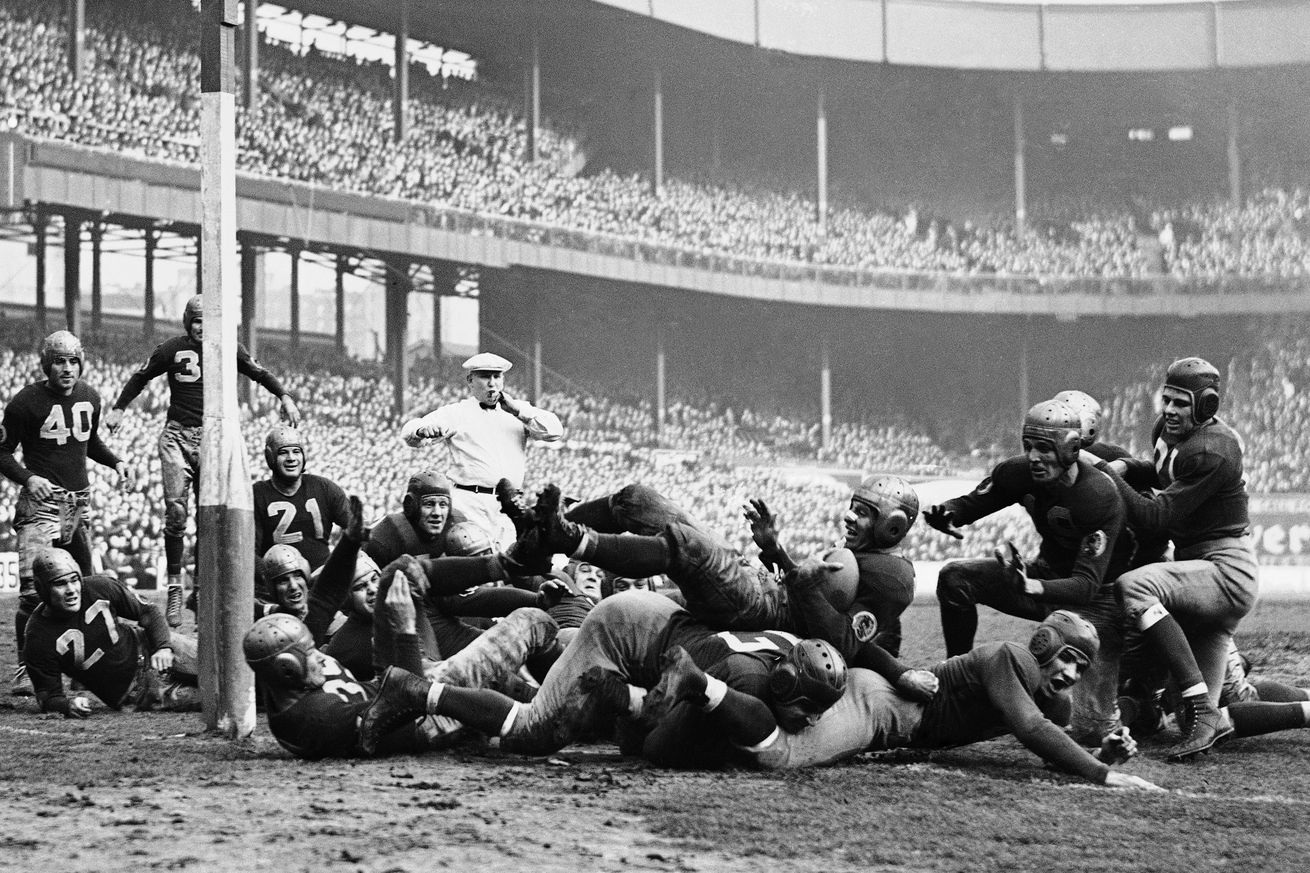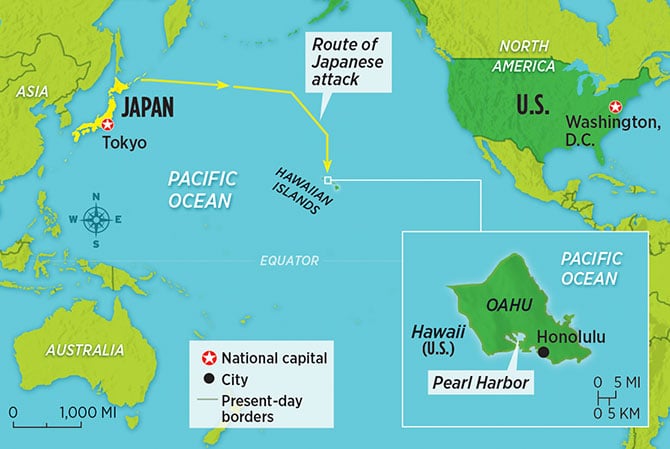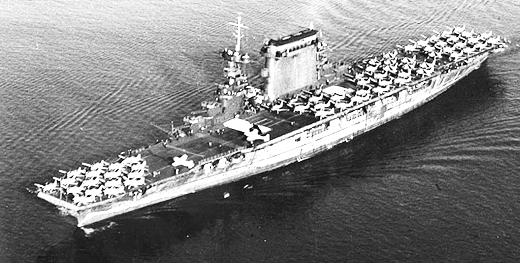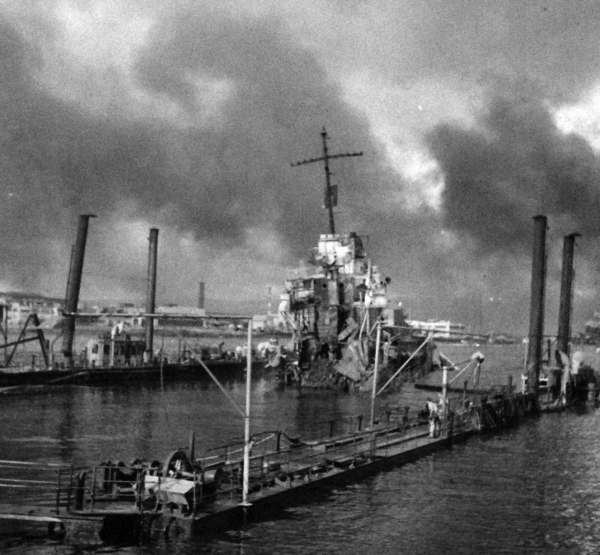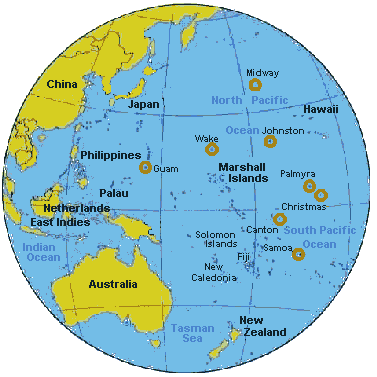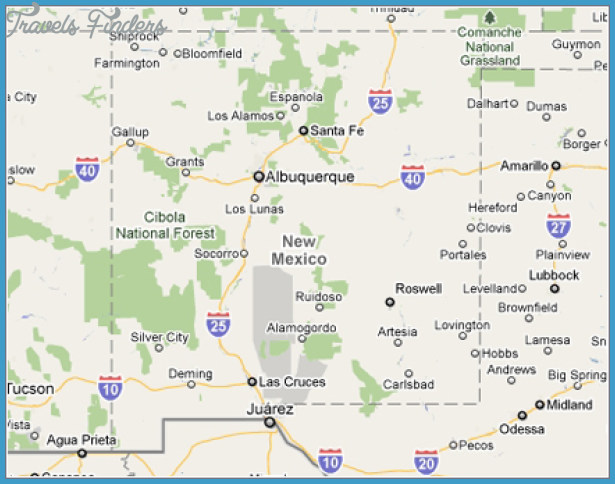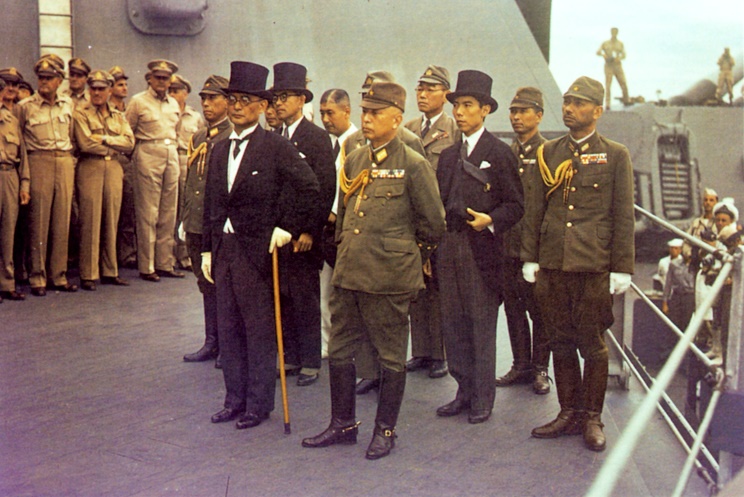Pearl Harbor
December 7th, 1941 – “A Day That Will Live In Infamy”
Think of it, you are relaxing on a Sunday afternoon in early December. You decide to listen to the football game on the radio.
Family listening to radio
Picture taken at the game on December 7th, 1941 between the Washington Redskins and Philadelphia Eagles
You are having fun listening and then you hear this.:
What do you think??? Why did the Japanese do that? Where is Pearl Harbor? What does it mean for the country? What does it mean for me, my brother, my father? How will ALL my family be affected?
Where Did It Happen?
See japan on the left, and the U.S. on the right
WHY Did It Happen???
The strike was intended to hurt the U.S. Pacific Fleet (U.S. Navy In The Pacific Ocean). This would allow Japan to continue to conquer more territory as they went looking for natural resources such as oil and rubber in Malaya and the Netherlands East Indies.
Notice the highlighting to locate of both Malaya and Netherlands East Indies. Japan could get natural resources there they did not have on their own islands.
Japan felt they needed to attack us because we were starting to tell them to stop expanding and conquering their neighbors for selfish reasons. In fact we had stopped sending them materials they needed to keep making weapons. What made Japan the most angry with the U.S. was that after the Japanese had moved into the nearby country of French Indochina (Modern day Vietnam), the U.S. stopped sending oil to Japan in the Summer of 1941. THAT was when Japan started developing final plans to attack.
They felt that if they could hurt our Navy at Pearl Harbor enough then we would not have the power to stop them from expanding.
WHEN and HOW did It Happen???
The U.S. Navy ships the Japanese were attacking were kept at Pearl Harbor in Hawaii. Hawaii is a series of Islands, so the attack had to be made by Japanese navy ships. The distance was 3,901 miles, so they had to start out WAY ahead of time. In fact they left Japan November 26th, 1941.
In the mean time, their government people were in Washington D.C. bargaining for a deal so the two countries could get along. This had been going on for a long time, and they had decided they could not come to an agreement with the U.S., but they had decided to not tell the them right away so they could continue preparing their attack. The morning of December 7th, 1941 they were finally delivering a message to the U.S. about their desire to stop bargaining with the U.S. Government. However, this message said NOTHING about them going to war against us.
The Japanese government people are on the left and right of the U.S. government man they had been talking to. This picture was taken AFTER they had talked on December 7th, and AFTER the U.S. was aware the attack had started. Look at the expression on the face of the man in the middle. What do you think he was thinking at that moment?
The problem for them was that even this message was delivered after the attacks had started. That means it was considered a sneak attack, which made EVERYONE in the U.S very angry, and MUCH more likely to agree to go to war and do anything necessary to win.
The Attack
Both of these movie clips are from the same movie, and use some of the same scenes, but are not exactly the same. One starts earlier, and the other goes longer into the movie. You should watch both of them so you get the fullest view of the attack on Pearl Harbor.
Clip #2
It started at 6:53 a.m. in Hawaii on a Sunday morning, December 7th, 1941. People were sleeping. People were going to church. People were doing assigned jobs. People were relaxed because we were NOT at war.
This clip shows something that actually happened. An African American cook, Dorrie Miller, had been only allowed to work as a cook due to the discrimination of the time. however, when tit was needed, he got on this weapon, twin- 50 caliber machine guns, and shot down at least one Japanese plane.
The main targets of the Japanese were the U.S. Air Craft Carriers. Their names were: USS Lexington , the USS Enterprise, and USS Saratoga. The reason these were the main target was that they could carry their airplanes anywhere and launch them against the Japanese. However, NONE of them were at home in Pearl Harbor for the Japanese to hit.
U.S.S. Lexington with planes on deck
Instead the Japanese started attacking everything else. They attacked the Battleships.
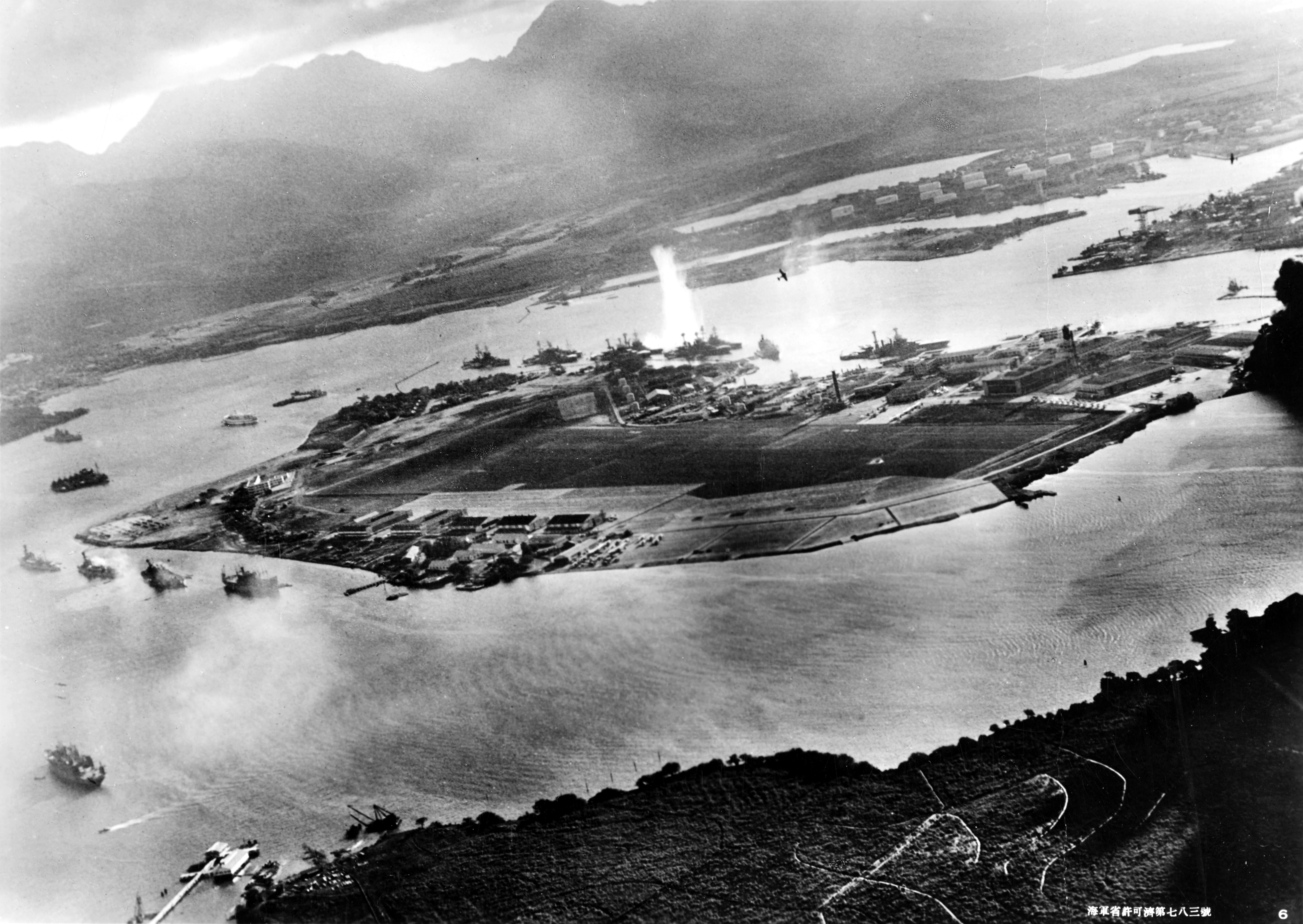
You can see the white splash of the 1st Japanese bomb hitting a U.S. Ship
They attacked smaller ships called Destroyers.
They even attacked the air base where some of the larger planes were kept. There were even bombs dropped on the Hospital by Japanese planes.
Some of the Sailors who could not be identified after being killed that morning were buried here
The Result:
The U.S. people wanted Japan to pay for what they had done, and not with money.

The Japanese surprise attack was the single biggest thing that changed the minds of people in the United States. They moved quickly from ISSOLATIONISM (REMEMBER WHAT THIS MEANS???) to direct involvement.
- We declared war on Japan on December 8th, , 1941 Listen to this first video to hear how President Roosevelt was greeted. when he starts speaking stop this one and move to the next.
This one lets you better hear him speaking, and see movement.
- See some of the words you just heard him say:
- Yesterday, December 7th, 1941 -- a date which will live in infamy -- the United States of America was suddenly and deliberately attacked by naval and air forces of the Empire of Japan.
The United States was at peace with that nation and, at the request of Japan, was still in conversation with its government and its emperor looking toward tkeeping peace in the Pacific.
Indeed, one hour after Japanese air squadrons had commenced bombing in the American island of Oahu, the Japanese ambassador to the United States and his colleague delivered to our Secretary of State a formal reply to a recent American message. And while this reply stated that it seemed useless to continue the existing diplomatic negotiations, it contained no threat or hint of war or of armed attack. - Japan declared war on the U.S. officially on December 8th (Don’t you think they did it with the first bomb dropped on December 7th???).
- Germany declared war on the U.S. on December 11th, 1941.
- The U.S. declared war on Germany and Italy on December 11th, 1941.
Four years later between 62 to 78 million people would be dead who were alive when the war started in 1939. 418,500 of them were U.S service people who had given their lives (died) fighting for freedom. In comparison, the Soviet Union had 26,954,000 men and women, both civilians and military (army) killed.
****************HERE I AM******************
More Fighting in The Pacific Area
******************************************030920
Battle of Midway: June 4th-7th, 1942
The United States was hurt a lot at Pearl Harbor.

Pearl Harbor Damage
Soon after that attack the Japanese also attacked us at The Philippines on December 8th, 1941, the day after Pearl Harbor. They finally defeated us there on the 8th of May, 1942.
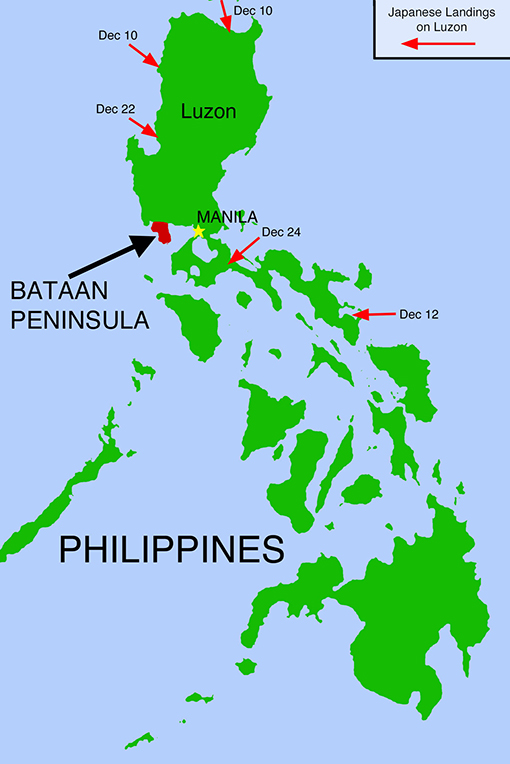
The Japanese landed all over (see red arrows), and soon had pushed us to just that little place in red, the Bataan Peninsula.
Things were not looking good for the United States in the war in The Pacific.
Between May 4th and 8th we and the Australians fought a battle at sea against the Japanese Navy. It was in an area of the Pacific called The Coral Sea.

The place where this fight happened is near Australia
The Japanese destroyed more of our ships and airplanes than we destroyed of theirs. However, we stopped the Japanese plan to invade Australia. It was kind of a draw (nobody won).

The place where this fight happened is near Australia
The Japanese destroyed more of our ships and airplanes than we destroyed of theirs. However, we stopped the Japanese plan to invade Australia. It was kind of a draw (nobody won).
This set the stage for what would happen two months later near a little island in the middle of the pacific controlled by The United States called Midway Island.
See Midway Island to the North and West of Hawaii
What Happened:
Japanese commander Admiral Isoroku Yamamoto moved toward Midway to try to get the U.S. ships to follow and attack him. He thought he was so much more powerful that he could destroy the U.S. Navy's aircraft carriers.
U.S.S. Enterprise aircraft carrier. See the planes on her deck?
Yamamoto's surprise was ruined by American communications information (intelligence), which figured out his plan well before the battle started. This allowed Admiral Chester W. Nimitz, the U.S. Pacific Fleet commander, to set an ambush (where you sneak up on someone and attack them). On 4 June 1942, the fight started.
At 0430 (4:30 AM) in the morning of 4 June 1942, still 240 miles away from Midway Island, Japan launched 108 attack planes from their four aircraft carriers to attack the U.S. base at Midway Island.
What the Japanese did not know was that there were three U.S. aircraft carriers only 215 miles from the Japanese ships. The two opposing fleets (groups of navy ships) sent out search planes to try to find each other. Seaplanes (planes that could land on water) from Midway were also patrolling along the expected Japanese attack path. One of these spotted, and reported, the Japanese ships at about 0530 (5:30 am).
What the Japanese did not know was that there were three U.S. aircraft carriers only 215 miles from the Japanese ships. The two opposing fleets (groups of navy ships) sent out search planes to try to find each other. Seaplanes (planes that could land on water) from Midway were also patrolling along the expected Japanese attack path. One of these spotted, and reported, the Japanese ships at about 0530 (5:30 am).
Ships and a plane of the U.S. Pacific Fleet
Remember, the Japanese, not knowing the U.S. Aircraft carriers were so near, were attacking the Midway Island. They did some damage to buildings on the island. Midway had U.S. airplanes, which attacked the Japanese ships, and were mostly shot out of the air and crashed.
The leaders of the U.S. navy ships decided they had to attack right away before the Japanese found them. They could not send all of their planes, but they sent the ones that were ready to go. They were torpedo planes (planes that can launch a torpedo from their belly. [The picture in the link show how they are about to fold down the wings on this plan so it can take off and attack the Japanese.])
Soon our torpedo planes (This picture is from about 7:30 am, 4 June 1942, the morning of the attack) attacked the Japanese ships. EVERY ONE of them was destroyed. Not a single U.S. torpedo hit a Japanese ship. All 15 U.S planes in the attack were shot down by Japanese fighter planes, killing all pilots.
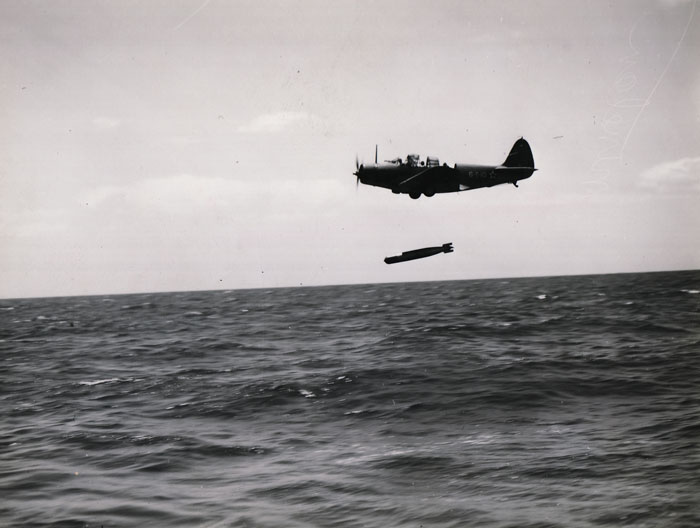
U.S. torpedo bomber. They dropped their torpedo into the water so it would go under water and hit an enemy ship
Those men’s lives were not wasted, because the Japanese planes protecting their ships were now out of gas and bullets, so they had to land to get more. The Japanese planes that had attacked the island were also getting more fuel, bombs, and bullets.
Then, when the Japanese heard that our aircraft carriers (ships that have planes on them) were near they started putting torpedoes on their planes to attack the ships, instead of more bombs to attack the island again. What this all means is that the Japanese were taking a LOT of time, and had all kinds of gas, bullets, bombs, and torpedoes sitting around on the deck their ships. The deck is the flat top where planes land and take off.
U.S. dive bomber aiming for Japanese ships
Why was that such a big deal? Well, what do YOU think would happened when bombs start hitting a place where there is a lot of gas, bullets, bombs, and torpedoes sitting around? Right, large BOOMS!!!
Movie scene of U.S. dive bombers hitting Japanese aircraft carriers
Mitsuo Fuchida, the Japanese pilot who led the attack on Pearl Harbor, was on the Akagi when it was hit, and described the attack:
“A look-out screamed: "Hell-Divers!" I looked up to see three black enemy planes plummeting towards our ship. Some of our machine guns managed to fire a few frantic bursts at them, but it was too late. The plump silhouettes of the American Dauntless dive-bombers quickly grew larger, and then a number of black objects suddenly floated eerily from their wings.”
| |
When the fighting was finally over on June 6th, 1942 we had sunk 4 of the most important Japanese aircraft carriers.
Japanese carrier Hiryu burning before sinking
One of the U.S. aircraft carriers, the USS Yorktown, was so badly damaged that she sank. Look here for a picture of what she looks like on the bottom of the ocean 16,650 feet down. That is over 3 miles.
Control tower and guns of USS Yorktown on bottom of Ocean today. Right now.
Why was The Battle of Midway such a BIG Turning Point???
Prior to this fight, Japan had a HUGE navy advantage over the United States and could usually pick where and when to attack. After Midway, the we were pretty much equal in power with the Japanese. This allowed US to soon start attacking the Japanese instead of sitting around waiting for them to hit us. Eventually we were stronger than the Japanese.
******************************************030920
Island Hopping and
Preparation to END the War
You remember from our discussion earlier how the Japanese attacked us at Pearl Harbor on December 7th, 1941. Then you remember how we defeated the Japanese at the Battle of Midway June 4th-7th, 1942. That was all OK, but to defeat Japan once and for all we had to dig them out of every island and every other country they had captured, and make our way to their Home Islands. They fought our attacks hard, and we had to come up with a plan to defeat them.
That plan came to be called “Island Hopping” because we would attack and capture an island from the Japanese, and then use it as a base to attack another island where the Japanese were. The goal was to get to their main Home Islands, because capturing those islands was thought to be the ONLY way to get the Japanese to give up and surrender.

The green arrows on this map show how the U.S. moved (hopped) from island to island, always moving closer to Japan
Iwo Jima : February 19th – March 26th, 1945

U.S. Marine artillery firing at the Japanese on Mount Suribachi

U.S. Marine artillery firing at the Japanese on Mount Suribachi
As we got closer to the Japanese Home Islands the Japanese soldiers fought harder and harder. At Iwo Jima we had 80,000 men attacking 20,00 Japanese soldiers. Yes, we outnumbered them by A LOT, but they had dug tunnels and caves all over the Island, which helped them defend themselves.

This shows the inside of a cave many years after the war. Kind of just like they left it.

This shows the inside of a cave many years after the war. Kind of just like they left it.
The final death toll among Marines was 5,931 killed in action, died of wounds or missing in action and presumed dead — more than twice as many Marines than had been killed in all of World War One. In all, more than 800 Americans gave their lives for every square mile of Iwo Jima.

U.S. Marine graves on Iwo Jima
Of the 21,000 Japanese soldiers present at the beginning of the battle, over 20,000 were killed and only 216 taken prisoner. We began to find out just what it would cost if we DID have to invade their Home Islands. They would fight to the death.

Okinawa:April 1st – June 21st, 1945

Okinawa is at the bottom of the map, and shows up in red. See how close is it to Japan? It is only about 340 miles away.

Okinawa is at the bottom of the map, and shows up in red. See how close is it to Japan? It is only about 340 miles away.
The Japanese considered this island almost like it was part of their Home Islands. We knew we would need to bring a lot of force to attack and defeat. We had over 60,000 Marines and Army soldiers to attack. We used over 1,300 ships to fire their big cannons at the Japanese before the soldiers landed.
During the first 24 hours of the attack those ships fired 7,600,000 pounds of cannon shells (That is = 3,800 mid sized SUV’s if each car weighs 2,000lbs.).
This is a bit long, but it DOES show U.S. artillery hitting the island before our Marines and soldiers went in
When it was all over we had won, gotten closer to Japan for the next step, which would be to attack their Home Islands. But there was a cost:
* 38,000 Americans wounded and 12,000 killed or missing,
* More than 107,000 Japanese and Okinawan soldiers killed of the 117,00 who were alive when the battle started (That is 91% killed)
* 100,000 Okinawan civilians (not army soldiers) killed.
The Japanese demonstrated they were not going to surrender easily, and that they were not afraid to fight where there were civilians in the way.
Operation Downfall
Operation Downfall was the plan to invade the Japanese Home Islands.
Japan is circled in red. Korea and China are to the left.
Okinawa showed just how costly it would be.
The planners of the attack learned that the Japanese Army was giving lunge mine weapons (someone using this weapon would shove the sticks on the end of it to cause the explosion.), and other weapons, to civilians, even young girls, so they could attack the invading Americans. They also had plans to strap bombs onto people who would go blow up U.S. ships, tanks, and soldiers themselves.
Lunge Mine: The 3 sticks were triggers that would cause the explosion when pressed against something
We would wind up having to fight ALL Japanese. One Japanese citizen called to prepare for battle was high school girl, Yukiko Kasai. The army gave her a hand spike to use as a weapon.
Hand spike to use as a weapon
They told her, "Even killing one American soldier will do. … You must aim for the stomach.’
The invading forces would be facing at least 900,00 Japanese soldiers and all the civilians who were prepared to fight. The estimates of casualties (killed and wounded) were as follows:
- 1,700,000 to 4,000,000 American killed and wounded
800,000 of those would be killed - 5,000,000 to 10,000,000 Japanese killed
But...We had something else that made this kind of attack not necesary.
Hiroshima and Nagasaki – Dropping The Atomic Bombs
August 6th and 9th, 1945
August 6th and 9th, 1945
Development of The Atomic Bomb
What many did not know was there was another weapon being
developed. In October of 1939 Two scientists, Leó Szilárd
and Albert Einstein, sent a letter to President Roosevelt.
They told the President that it was likely that in the near future
it would become possible to use science to cause an explosion
that would make and release HUGE amounts of power.
They made the point that this technology could be used to
produce weapons more powerful than anyone imagined.
It was known that Germany was experimenting and trying to
develop this technology. So the decision was made to start a
program to discover what could be done. It would eventually
employ 130,000 people in at least 3 different countries,
and cost $2,000,000,000.
In order to really develop this idea they needed space, lots of it.
They needed to have rooms to do experiments in, and other
rooms for scientists and workers to live in. One way this was
done in the area of Los Alamos, New Mexico.
You can see Los Alamos in the northern part of this map.
They sent a letter to the school telling them the government was taking
their school:
Mr. A. J. Connell
President and Director
Los Alamos Ranch School
Espanola, New Mexico
Dear Sir:
You are advised that it has been determined
necessary to the interests of the
United States in the prosecution of
the War that the property of the
Los Alamos Ranch School be acquired
for military purposes.
Therefore, pursuant to existing law, a condemnation proceeding
will be instituted in the United States District Court for the District of
New Mexico to acquire all of the school's lands
and buildings, together with all personal
property owned by the school and used
in connection with its operation.
Although the acquisition of this property is of the utmost importance in the
prosecution of the war, it has been determined that it will not be necessary
for you to surrender complete possession of the premises until
February 8, 1943. It is felt that this procedure will enable you to complete
the first term of the regular school year without interruption.
You are further advised that all records pertaining to the
aforesaid condemnation proceeding will
be sealed, by order of the Court, and public
inspection of such records will be
prohibited. Accordingly, it is requested that you refrain from making
the reasons for the closing of the school known to the public at large.
Sincerely Yours,
[Henry Stimson]
Secretary of War.
|
This is the actual letter that was received. Does it look fancy enough for something that really was such a big deal?
Once the bomb was developed they needed to test it. Even the
scientists had no idea of what would really happen.
The testing required different steps:
Setting up the test. Look at how big the bomb piece was
at the end
Moving the plutonium core (the part that makes the explosion). It starts a chain reaction that releases a LOT of energy. That can destroy things.
Were they really doing this safely???
Were they really doing this safely???
The “Jumbo Device” that was designed as a backup to hold the main
explosive thing in case the nuclear part did not explode.
It cost $12 million to build, and was a steel cylinder 10 feet in diameter
and 25 feet long. Its walls were 14 inches thick and the entire device
weighed 200 tons.
This was the Trinity Explosion (The very first nuclear explosion) in color
This is the main scientist, Robert J. Oppenheimer, speaking about the 1st nuclear blast. Look at his facial expressions, and the way he was talking. What does that indicate about what he was thinking?
It was another version of this weapon that President Truman
(Roosevelt had died in April, 1945) decided to drop on Japan
in August when they would not surrender.
First Bomb - Dropped on Hiroshima on August 6th, 1945.


On 6 August 1945, a specially changed B-29 bomber lifted off from an airfield on an island in the Pacific named Tinian. The bomb was dropped from the plane at 31,600 feet.
.jpg)
.jpg)
Enola Gay - The B-29 that dropped The Bomb
The bomb exploded 1,750 feet in the air. The blast was later estimated to be the equal of 13,000 tons of TNT (an explosive) An area approximately 4.7 square miles (a square that has each side equal to 4.7 miles) was completely destroyed. Japanese officials determined that 69% of Hiroshima's buildings were destroyed and another 6–7% damaged. About 70,000 to 80,000 people, or some 30% of the population of Hiroshima, were killed immediately, and another 70,000 injured.


The middle of the place in Hiroshima that was destroyed by the bomb.
This video shows the explosion over Hiroshima
See a movie clip of what it might have been like:
Second Bomb – Dropped on Nagasaki on August 9th, 1945
The Japanese did not surrender, even after they witnessed the power of the new weapon we had. President Truman then decided to drop another atomic bomb. It wound up being released over the city of Nagasaki because the weather over the first target city made hard it to see.
Eplosion of the bomb over Nagasaki
Japan surrendered on August 15th, 1945 when Emperor Hirohito made a radio broadcast. It was called VJ Day, which meant Victory over Japan.
The Japanese delegation aboard the USS Missouri, a battleship
The war was over.
Hideki Tojo, the former military leader of Japan, tried to kill himself, but was captured, tried as a war criminal, and then executed on December 23rd, 1948.
